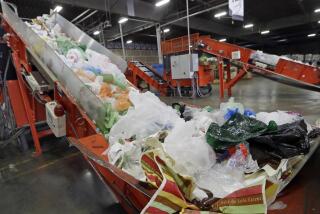Editorial: It was a perfect California beach day...except for all the plastic pollution
- Share via
It was a perfect beach day. As temperatures inland climbed to the high 80s on Saturday, it was pleasantly warm and breezy at the tiny County Line Beach north of Malibu.
The water was bracingly cold. It’s not summer yet. As I took a break at the waters edge to warm up my freezing feet, I poked around in what’s known as the “wrack line.” This is the narrow band of seaweed, driftwood and other debris that gets washed in on the tide. I picked up one of the white shell fragments dotting the line for a closer look.
Wait. It wasn’t a shell at all. With disgust I realized I was holding a piece of polystyrene — the plastic foam widely, but often wrongly, known as Styrofoam. It was probably part what had once been a take-out container or coffee cup that had broken apart at sea and then floated to shore. My horror grew as I realized that all the little white things littering the beach around me were pieces of polystyrene. There was plastic foam bobbing in the tide as well.
I have been writing about plastic litter in the oceans and beaches for years. And I knew that polystyrene foam is one of the most ubiquitous sources of litter collected during local beach cleanups, along with cigarette butts. But I had never before seen the full scale of it. I was in the right place at the right time for such an experience, I found out later after talking to Sarah Sikich, a marine biologist and vice president of Heal the Bay. It was windy with a good swell, and the tide was going out — perfect conditions for floating plastic pollution to get stranded on shore.
Foam containers get battered as they move through the storm drain system, the smaller bits slipping through filters into the ocean.
Of course, it’s the stuff that doesn’t wash up on the beach, and remains in the water, that causes the biggest environmental concern. Mostly these are small pieces of polystyrene from land, discarded somewhere other than the trash can and blown into the rivers or storm drains. Foam containers get battered as they move through the storm drain system, the smaller bits slipping through filters into the ocean. Unlike a littered plastic bag, which may fill with water and sink to the bottom of the sea, plastic foam is buoyant and breaks down into smaller and smaller bite-sized pieces. Also, plastic foam can absorb other chemicals present in the ocean.
This poses a danger to marine life and sea birds that eat the “microplastic” pieces in the water and on the shore, along with whatever pollutants they contain. It also poses a health risk to humans, as plastic has been found in the bodies of fish and shellfish caught for human consumption.
About 100 cities and counties in the state have laws restricting food vendors from using polystyrene take-out containers. Clearly, 100 local rules haven’t entirely stopped the flow of foam, which can originate far from the beach. That’s why a state law proposed this year, the Ocean Pollution Reduction Act of 2017 (SB 705), makes sense. It would ban stores and restaurants from using polystyrene containers for prepared food starting in 2020. It’s based on a polystyrene take-out ban enacted by Santa Monica in 2008.
The bill is working its way through the legislative process, but it’s likely to get hung up at some point when the plastics industry starts lobbying. This isn’t the first time a statewide polystyrene ban has been proposed. If history is any indication, one of the main arguments against the ban will be economic: Foam is inexpensive and using an alternative would add to food vendors’ overhead and drive up prices. Santa Monica was sensitive to this possibility and included a one-year hardship exemption for businesses that couldn’t afford to switch to a higher-cost alternative. Apparently, it didn’t turn out to be a big burden because, according to Santa Monica officials, not one exemption was requested.
I hope state lawmakers skeptical of a statewide ban make a trip to County Line Beach on a breezy day at low tide before casting a “no” vote. They will see that the problem with plastic foam isn’t academic. It’s lying right at their feet.
Follow the Opinion section on Twitter @latimesopinion and Facebook
MORE:
Trump’s incoherence on Iran doesn’t serve U.S. interests
UC’s $175 million in hidden funds might not be $175 million — and they might not be hidden
More to Read
A cure for the common opinion
Get thought-provoking perspectives with our weekly newsletter.
You may occasionally receive promotional content from the Los Angeles Times.










